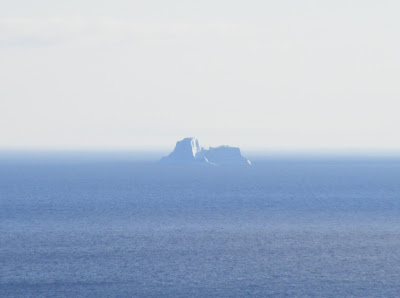We drove north and then east through a heavily wooded part
of Newfoundland to La Scie. La Scie is an isolated outport on the north central
coast. To get there, some of the secondary roads were pitchy and potholed
giving Penny a rough ride. Often, when Jeep was lurching one way, Penny was going the
other. But, as we drove down into the harbour it all seemed worthwhile. We were
immediately taken by the beauty and ruggedness of the coastline.
The town was founded by seasonal French fishermen but
settled by the English, and has a long and difficult history not unlike most of
Newfoundland's outports. However, at the present, it appears to have a
sustainable crab fishery.
We didn't have the campground address, so in minutes found
the local people helpful, friendly and very welcoming. Over the course of our
stay, the teenagers we met were very much
like the adults in that regard. In our travels, at times we've had more difficulty connecting with the teenagers, but maybe it's just the grey hair.
There were steep headlands on both sides of the harbour, and
our campsite was perched high on top of the eastern shore. The view out to sea was spectacular
with icebergs majestically drifting by in the distance, pushed by the wind and
pulled by the tide. Local folks suggested we should watch for whales in the
cove and moose around the campground. It was just our kind of place.
Surrounded by steep cliffs and just below our campsite,
there was a beach along a cove within the cove. It was perfect for beachcombing
with an abundance of sun bleached driftwood and other relics which had blown
ashore and laid amongst the smoothly polished stones.
Without any protection from the elements, overnight, wind
gusts rocked Penny but temperatures stayed in the high teens. Weather forecasts
for the next day called for unseasonable "blistering temperatures" in
the twenties. Needless to say, we had a chuckle, but of course everything is
relative. With the warm temperatures and sunshine, the afternoon winds were refreshing
and welcome to keep the few blackflies away.
Trails led in various directions from our campsite. They
were generally rough as the rock rubble was course and loose, but they took us
to scenic places, a lookout, the harbour, down to the beach and more. Much of
the cliffed shoreline was dry and hikeable, and allowed us to get off the
beaten trails and go where others didn't.
On our last evening, after dinner, we took a couple of Amarettos
out on the cliff near our camp. We were watching the sun set and reflecting on
our stay, feeling that we'd seen everything that we had come to see at La Scie.
But, shortly after sunset, there appeared to be fog developing on the horizon,
and as we watched, the dense fog started moving our way at a considerable
speed. Now we'd heard Newfoundland stories of heavy fog moving in quickly and
catching fishermen not knowing how to get home. Within a few minutes the wall
had almost reached us, but then all of a sudden it stopped advancing, and
drifted southwest over the headland. It was an awesome sight, but scary
to imagine being caught out at sea in such conditions.
We'll always remember La Scie for not only that experience,
but also its people and the spectacular scenery along the rugged north central
coast of Newfoundland.
Click here for the next story in this series:
http://travellingwithsteveandmarlene.blogspot.ca/2017/06/kudos-and-other-things-newfoundland.html
Click here for the next story in this series:
http://travellingwithsteveandmarlene.blogspot.ca/2017/06/kudos-and-other-things-newfoundland.html









